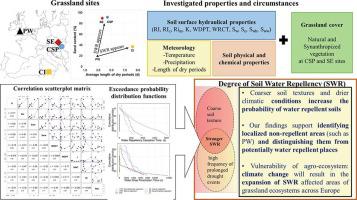Our official English website, www.x-mol.net, welcomes your
feedback! (Note: you will need to create a separate account there.)
Impact of climate, soil properties and grassland cover on soil water repellency
Geoderma ( IF 5.6 ) Pub Date : 2021-02-01 , DOI: 10.1016/j.geoderma.2020.114780 Renáta Sándor , Massimo Iovino , Lubomir Lichner , Vincenzo Alagna , Daniel Forster , Mariecia Fraser , Jozef Kollár , Peter Šurda , Viliam Nagy , Anita Szabó , Nándor Fodor
Geoderma ( IF 5.6 ) Pub Date : 2021-02-01 , DOI: 10.1016/j.geoderma.2020.114780 Renáta Sándor , Massimo Iovino , Lubomir Lichner , Vincenzo Alagna , Daniel Forster , Mariecia Fraser , Jozef Kollár , Peter Šurda , Viliam Nagy , Anita Szabó , Nándor Fodor

|
Abstract Numerous soil water repellency (SWR) studies have investigated the possible causes of this temporal phenomenon, yet there remains a lack of knowledge on the order of importance of the main driving forces of SWR in the context of changing environmental conditions under grassland ecosystems. To study the separate and combined effects of soil texture, climate, and grassland cover type on inducing or altering SWR, four sites from different climatic and soil regions were selected: Ciavolo (CI, IT), Csolyospalos (CSP, HU), Pwllpeiran (PW, UK), Sekule (SE, SK). The investigated parameters were the extent (determined by repellency indices RI, RIc and RIm) and persistence (determined by water drop penetration time (WDPT) and water repellency cessation time, WRCT) of SWR, as well as field water (Sw) and ethanol (Se) sorptivity, water sorptivity of hydrophobic soil state (Swh) water sorptivity of nearly wettable soil state (Sww) and field hydraulic conductivity (K). Our findings showed an area of land has a greater likelihood of being water repellent if it has a sandy soil texture and/or a high frequency of prolonged drought events. Water infiltration was positively correlated with all the sorptivities (r = 0.32–0.88), but was mostly negatively correlated with RI (r = – 0.54 at CI), WDPT (r = – 0.47 at CI) and WRCT (r = – 0.58 at CI). The importance of natural and synanthropized vegetation covers with regards to SWR was not coherent; moving to regions having coarser texture or moving to drier climatic zones led to higher risk of SWR conditions. Climate change has been predicted to lead to more frequent extreme weather events and prolonged dry periods across Europe, which will most likely increase the extent of SWR-affected areas and increase the role of SWR in water management of grassland ecosystems. Therefore, there is a need to determine SWR risk zones to prevent decreases in soil moisture content, soil fertility, carbon and nitrogen sink potentials, as well as biomass production of the related agro-ecosystems.
中文翻译:

气候、土壤性质和草地覆盖对土壤拒水性的影响
摘要 许多土壤拒水性 (SWR) 研究已经调查了这种时间现象的可能原因,但在草地生态系统环境条件不断变化的背景下,关于 SWR 主要驱动力的重要性顺序仍缺乏了解。为了研究土壤质地、气候和草地覆盖类型对诱发或改变 SWR 的单独和综合影响,选择了来自不同气候和土壤区域的四个站点:Ciavolo (CI, IT)、Csolyospalos (CSP, HU)、Pwllpeiran ( PW,英国),Sekule(SE,SK)。研究的参数是 SWR 的范围(由拒水指数 RI、RIc 和 RIm 确定)和持久性(由水滴渗透时间(WDPT)和拒水停止时间,WRCT 确定),以及田间水(Sw)和乙醇(Se) 吸附性,疏水土壤状态的吸水率 (Swh) 近可湿土壤状态的吸水率 (Sww) 和田间水力传导率 (K)。我们的研究结果表明,如果一块土地具有沙质土壤质地和/或长期干旱事件的高频率,则该土地区域具有更大的防水性。水渗透与所有吸附性呈正相关 (r = 0.32–0.88),但大部分与 RI (r = – 0.54 在 CI)、WDPT (r = – 0.47 在 CI) 和 WRCT (r = – 0.58 在 CI) 呈负相关CI)。自然和人工合成植被覆盖对 SWR 的重要性不一致;迁移到质地较粗糙的地区或迁移到较干燥的气候区会导致 SWR 条件的风险更高。预计气候变化将导致更频繁的极端天气事件和整个欧洲的干旱期延长,这很可能会增加受 SWR 影响的地区的范围,并增加 SWR 在草地生态系统水管理中的作用。因此,需要确定 SWR 风险区,以防止土壤水分含量、土壤肥力、碳和氮汇潜力以及相关农业生态系统的生物量生产下降。
更新日期:2021-02-01
中文翻译:

气候、土壤性质和草地覆盖对土壤拒水性的影响
摘要 许多土壤拒水性 (SWR) 研究已经调查了这种时间现象的可能原因,但在草地生态系统环境条件不断变化的背景下,关于 SWR 主要驱动力的重要性顺序仍缺乏了解。为了研究土壤质地、气候和草地覆盖类型对诱发或改变 SWR 的单独和综合影响,选择了来自不同气候和土壤区域的四个站点:Ciavolo (CI, IT)、Csolyospalos (CSP, HU)、Pwllpeiran ( PW,英国),Sekule(SE,SK)。研究的参数是 SWR 的范围(由拒水指数 RI、RIc 和 RIm 确定)和持久性(由水滴渗透时间(WDPT)和拒水停止时间,WRCT 确定),以及田间水(Sw)和乙醇(Se) 吸附性,疏水土壤状态的吸水率 (Swh) 近可湿土壤状态的吸水率 (Sww) 和田间水力传导率 (K)。我们的研究结果表明,如果一块土地具有沙质土壤质地和/或长期干旱事件的高频率,则该土地区域具有更大的防水性。水渗透与所有吸附性呈正相关 (r = 0.32–0.88),但大部分与 RI (r = – 0.54 在 CI)、WDPT (r = – 0.47 在 CI) 和 WRCT (r = – 0.58 在 CI) 呈负相关CI)。自然和人工合成植被覆盖对 SWR 的重要性不一致;迁移到质地较粗糙的地区或迁移到较干燥的气候区会导致 SWR 条件的风险更高。预计气候变化将导致更频繁的极端天气事件和整个欧洲的干旱期延长,这很可能会增加受 SWR 影响的地区的范围,并增加 SWR 在草地生态系统水管理中的作用。因此,需要确定 SWR 风险区,以防止土壤水分含量、土壤肥力、碳和氮汇潜力以及相关农业生态系统的生物量生产下降。











































 京公网安备 11010802027423号
京公网安备 11010802027423号